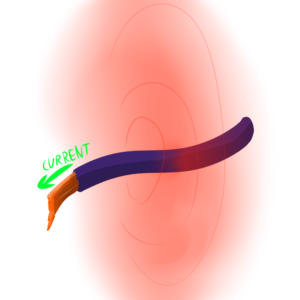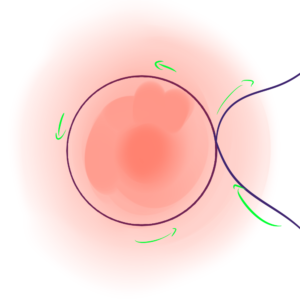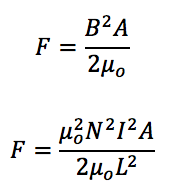How can I create an electromagnet strong enough to pull a small metal object (e.g.) a fork in from 25-30 feet away? Basically, I want a very strong electromagnet with a large reach. I want to know a theoretically super-powerful design, and, if possible, a method of constructing this at home.
If there are any dangers to this, please make sure to mention them in your answer. However, please tell me how regardless if it can give me cancer or something like that. Thanks!
Eric Pavlotskiy
***
Great question! In order to maintain plausible deniability, I won’t ask why you want a device this powerful, or what you plan on doing with the fork.

All art in this post is from the Art Nerd. Thanks man.
The short answer is that an electromagnet capable of pulling in an object from that far is impractical, expensive, undeniably deadly, and most definitely enough to guarantee entry into the Evil League of Evil (not affiliated with the League of Nerds).
The Long Answer
What is an electromagnet?
An electromagnet is a magnet with an electrical current running through it, which produces a surrounding electric field. Unlike permanent magnets, the ones holding up your good test grades and dinosaur drawings on the refrigerator, electromagnets require an external source of energy. When this source of energy is cut off, the electromagnet will stop being magnetic. Since they can be turned on and off, electromagnets are particularly useful for picking up, holding, and releasing large metal objects, like a car in a junkyard.
How do I make one? (Try at own risk)
Making an electromagnet is relatively easy. All you need is an energy source, such as a battery, and a coil of wire. When you connect the wire to the battery a current flows through the wire, creating a relatively weak magnetic field around it.*
If you take this wire and make a loop, the magnetic field will be concentrated in the center.
You can then make more loops to increase this effect.
And if you really want to increase the effect, then instead of just making loops in the air, you need to put in a magnetic core. Iron is roughly 5000 times better than air at supporting a magnetic field within itself.
 For this question, the phrase “within itself” is crucial. This core dramatically increases the strength of the magnetic field inside all those loops, but electrical and magnetic energy decrease exponentially as you travel away from the source. And I’m not using “exponentially” as a vague “pretty fast” modifier here – I mean you need to start doing math with exponents, so the energy is going to shrink fast. The iron core will increase the max weight your electromagnet can pull by a factor of 5000, but will have no impact on anything beyond its immediate area.
For this question, the phrase “within itself” is crucial. This core dramatically increases the strength of the magnetic field inside all those loops, but electrical and magnetic energy decrease exponentially as you travel away from the source. And I’m not using “exponentially” as a vague “pretty fast” modifier here – I mean you need to start doing math with exponents, so the energy is going to shrink fast. The iron core will increase the max weight your electromagnet can pull by a factor of 5000, but will have no impact on anything beyond its immediate area.
Electromagnetic Fork Launcher Of Death (The Extra Long Answer)
Warning: the following section will get very mathy very fast. Feel free to skip to the conclusion.
For this design you asked for a range of 25-30 feet. Since we’re working with exponents, there’s actually a big difference between the beginning and ending of that range. Attracting a fork at 30 feet requires 44% more energy than that of 25.
 I’ll be using a range of 25 feet to help scale down the size of this device.
I’ll be using a range of 25 feet to help scale down the size of this device.
We need to generate a magnetomotive force strong enough to move a fork from 25 feet away. I don’t have a scale in my kitchen, so I’m trusting google that a fork weighs about 0.055 lbf (pounds-force), which is roughly 0.245 newtons.
The force exerted by a magnetic field is given by the following equation:
 Where F is the weight of the fork (hey that worked out!), A is the cross-sectional area of our coils and B is the strength of the magnetic field at the location of the fork. µ0 is a measur of how good the air is at supporting a magnetic field, which is a constant. Specifically, it’s 4π10-707 Henry/meter. (Which is 1/5000th as good as an iron core, remember? When the iron core comes back up in a minute we’ll label its support ability µr.)
Where F is the weight of the fork (hey that worked out!), A is the cross-sectional area of our coils and B is the strength of the magnetic field at the location of the fork. µ0 is a measur of how good the air is at supporting a magnetic field, which is a constant. Specifically, it’s 4π10-707 Henry/meter. (Which is 1/5000th as good as an iron core, remember? When the iron core comes back up in a minute we’ll label its support ability µr.)
We know F is 0.245 newtons, and we make up A ourselves when we decide how big our wire loops are. In order to calculate B, though, we need to use Ampere’s law to see how the magnetomotive force we make will be distributed between the core and the air around it. N is the number of loops, also our choice, and I is the current going through the loops.
 When we integrate, we get two important lengths: the length of the core, and the length of the air between the electromagnet and the fork.
When we integrate, we get two important lengths: the length of the core, and the length of the air between the electromagnet and the fork.
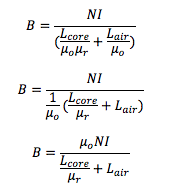 Looking at the term on the bottom, we have the length of the magnet divided by that 5000, plus the length of the air gap between the fork and the electromagnet. Compared to 25 feet, Lcore/5000 is effectively zero. The length of the core will have no impact on the strength of the magnetic field.
Looking at the term on the bottom, we have the length of the magnet divided by that 5000, plus the length of the air gap between the fork and the electromagnet. Compared to 25 feet, Lcore/5000 is effectively zero. The length of the core will have no impact on the strength of the magnetic field.
This simplifies B to:
 And now we can go back to the force equation and stick that in for B.
And now we can go back to the force equation and stick that in for B.
 Okay, now we have something we can work with. We know F is 0.245 newtons, and we want length L to be 25 feet away from the electromagnet. Plus μo is still 4π10-7 because… it’s still a constant. So let’s put everything we can plug in numbers for on one side and crunch those:
Okay, now we have something we can work with. We know F is 0.245 newtons, and we want length L to be 25 feet away from the electromagnet. Plus μo is still 4π10-7 because… it’s still a constant. So let’s put everything we can plug in numbers for on one side and crunch those:

![]() Now we only have three more parameters to figure out: number of loops N, how much current I, and area inside the loops A. And we make up N and A ourselves. We need a coil that can make a HUGE magnetic field, so I’m going to say the radius of the wire loops should be 2 feet, giving us an area of 12.56 feet square. While I’m on it, I will also arbitrarily give the coil 250 loops.
Now we only have three more parameters to figure out: number of loops N, how much current I, and area inside the loops A. And we make up N and A ourselves. We need a coil that can make a HUGE magnetic field, so I’m going to say the radius of the wire loops should be 2 feet, giving us an area of 12.56 feet square. While I’m on it, I will also arbitrarily give the coil 250 loops.
Dividing this out yields:
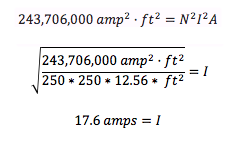 Okay! We are almost there. Air will eventually reach a saturation point where the magnetomotive force no longer gets bigger even with more current or more loops. This occurs at 800 amp turns per meter. So a coil with only one amp of current could have up to 800 loops per meter, or vice versa one with 800 amps could only support one loop per meter. We have 250 turns and 17.6 amps, and multiplying these two gives our coil 4250 amp turns.
Okay! We are almost there. Air will eventually reach a saturation point where the magnetomotive force no longer gets bigger even with more current or more loops. This occurs at 800 amp turns per meter. So a coil with only one amp of current could have up to 800 loops per meter, or vice versa one with 800 amps could only support one loop per meter. We have 250 turns and 17.6 amps, and multiplying these two gives our coil 4250 amp turns.
Dividing this by our saturation point tells us that our coil needs to be 5.3 meters long, or roughly 17.7 feet. That’s right, our electromagnet will be about the size of a hula-hoop and span almost the length we are trying to make a fork fly.
In order to pull 18 amps through nearly 3200 feet of coil windings, we need a current source that can provide 360 volts (18A*20Ω = 360V). If you still somehow want to make this at home you can wire up several car batteries. These batteries provide 12.6V at 5.4 max amps. To get to 360 volts you will need to stack 29 batteries. And to get at least 18 amps you will need 4 of these stacks in parallel, for 116 total car batteries.
Now as to the dangers of this, let’s see what the radiation looks like right next to the coil:
 According to the Institute of Electrical and Electronics Engineers, the absolute maximum radiation a human can stand is 2000 mGauss, and negative side effects can start as low as 3 mGauss.
According to the Institute of Electrical and Electronics Engineers, the absolute maximum radiation a human can stand is 2000 mGauss, and negative side effects can start as low as 3 mGauss.
Conclusion:
If you have over half a mile of copper and 116 spare car batteries lying around then you too can make a fork fly across your yard, but you’ll probably die in the process.
The takeaway is that electromagnets are incredibly useful for picking up and releasing heavy objects. They aren’t useful at all for living out Star Wars fantasies in your backyard.
Yours,
The Electromagnetics Nerd
*PSA: Please don’t short your battery. Attach a resistor to your wire to limit how much current the battery will output.
Got a question? Ask a nerd! asktheleagueofnerds@gmail.com
Twitter @AskTheLeague / facebook.com/asktheleagueofnerds
For more, check out Hackaday: these guys built an electromagnet to try and summon a Captain America shield. It holds up a car from a few inches away… but can’t pull in a damn thing beyond about a foot. Life’s tough, and we can’t all be Magneto.
[Note from the Language Nerd: This is in fact the very first question ever sent in to the League. I’ve been searching for someone to answer it for years — a huge thank you to Erich Myers for his brilliant post!]
